Zara: Applied Corporate Strategy Assessment Report - Business Strategy
VerifiedAdded on 2020/12/09
|8
|2225
|379
Report
AI Summary
This report offers a comprehensive analysis of Zara's corporate strategy, beginning with an examination of its external business environment and industry dynamics to identify opportunities and threats. It then delves into an internal analysis, assessing Zara's resources and core competencies, followed by an application of Porter's Five Forces model to understand the competitive landscape. The report also employs the VRIO framework to evaluate Zara's resources and capabilities for sustained competitive advantage. Furthermore, it evaluates a recently implemented sustainability strategy using the SAFe criteria (suitability, acceptability, and feasibility), highlighting Zara's commitment to eco-efficiency and sustainable practices. The analysis covers Zara's strengths, weaknesses, and strategic choices within the context of the fashion retail industry, concluding with insights into its competitive positioning and future prospects.
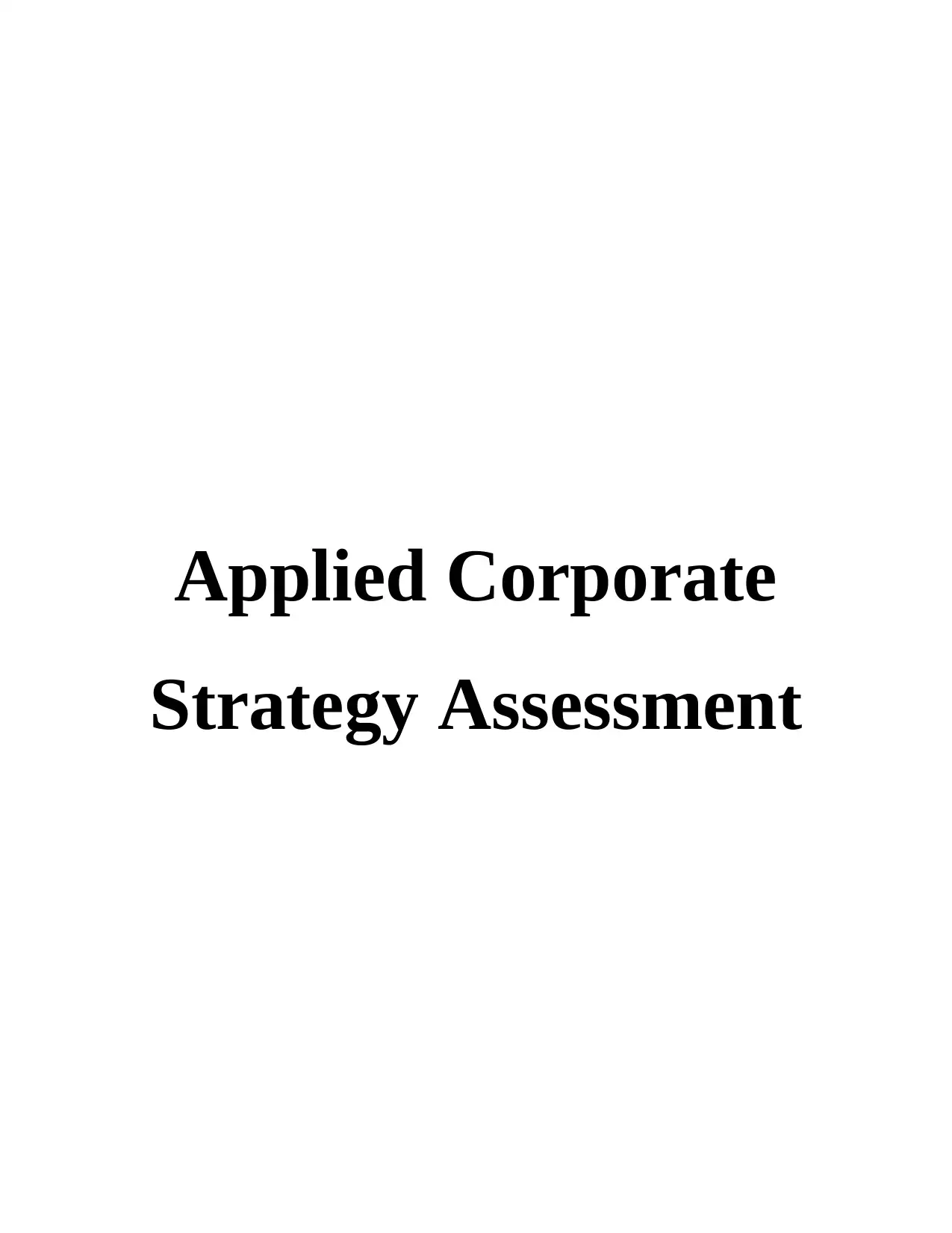
Applied Corporate
Strategy Assessment
Strategy Assessment
Paraphrase This Document
Need a fresh take? Get an instant paraphrase of this document with our AI Paraphraser
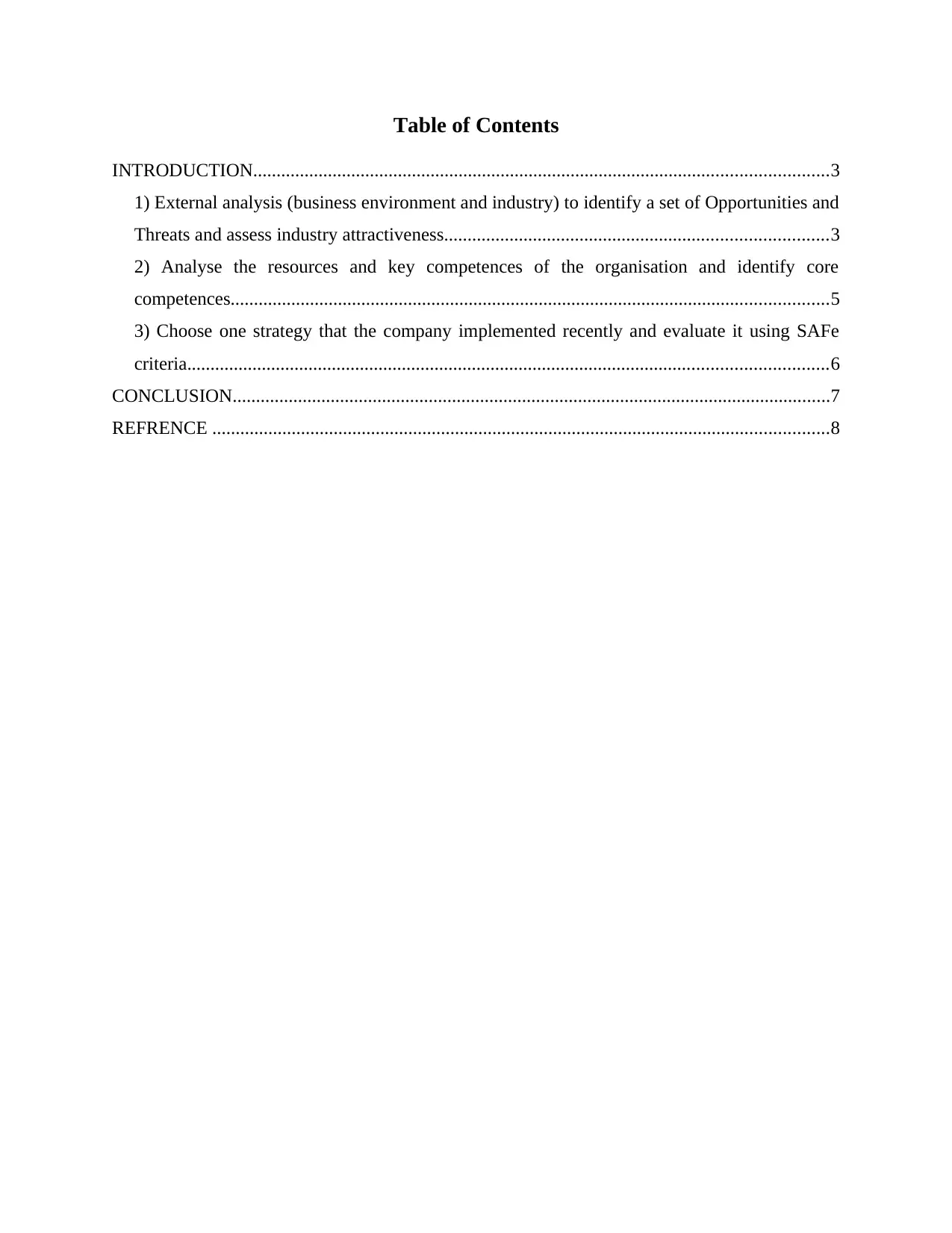
Table of Contents
INTRODUCTION...........................................................................................................................3
1) External analysis (business environment and industry) to identify a set of Opportunities and
Threats and assess industry attractiveness..................................................................................3
2) Analyse the resources and key competences of the organisation and identify core
competences................................................................................................................................5
3) Choose one strategy that the company implemented recently and evaluate it using SAFe
criteria.........................................................................................................................................6
CONCLUSION................................................................................................................................7
REFRENCE ....................................................................................................................................8
INTRODUCTION...........................................................................................................................3
1) External analysis (business environment and industry) to identify a set of Opportunities and
Threats and assess industry attractiveness..................................................................................3
2) Analyse the resources and key competences of the organisation and identify core
competences................................................................................................................................5
3) Choose one strategy that the company implemented recently and evaluate it using SAFe
criteria.........................................................................................................................................6
CONCLUSION................................................................................................................................7
REFRENCE ....................................................................................................................................8
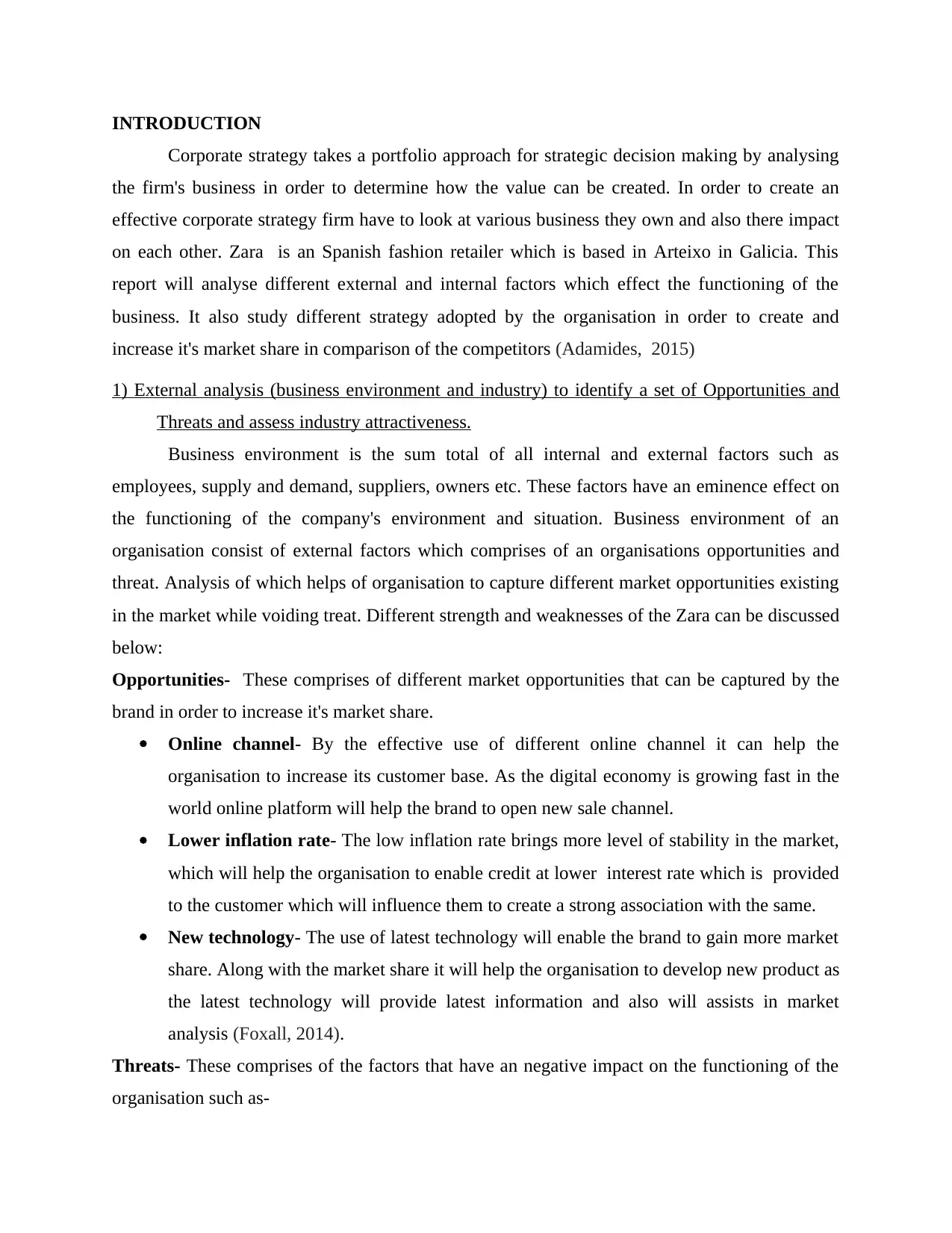
INTRODUCTION
Corporate strategy takes a portfolio approach for strategic decision making by analysing
the firm's business in order to determine how the value can be created. In order to create an
effective corporate strategy firm have to look at various business they own and also there impact
on each other. Zara is an Spanish fashion retailer which is based in Arteixo in Galicia. This
report will analyse different external and internal factors which effect the functioning of the
business. It also study different strategy adopted by the organisation in order to create and
increase it's market share in comparison of the competitors (Adamides, 2015)
1) External analysis (business environment and industry) to identify a set of Opportunities and
Threats and assess industry attractiveness.
Business environment is the sum total of all internal and external factors such as
employees, supply and demand, suppliers, owners etc. These factors have an eminence effect on
the functioning of the company's environment and situation. Business environment of an
organisation consist of external factors which comprises of an organisations opportunities and
threat. Analysis of which helps of organisation to capture different market opportunities existing
in the market while voiding treat. Different strength and weaknesses of the Zara can be discussed
below:
Opportunities- These comprises of different market opportunities that can be captured by the
brand in order to increase it's market share.
Online channel- By the effective use of different online channel it can help the
organisation to increase its customer base. As the digital economy is growing fast in the
world online platform will help the brand to open new sale channel.
Lower inflation rate- The low inflation rate brings more level of stability in the market,
which will help the organisation to enable credit at lower interest rate which is provided
to the customer which will influence them to create a strong association with the same.
New technology- The use of latest technology will enable the brand to gain more market
share. Along with the market share it will help the organisation to develop new product as
the latest technology will provide latest information and also will assists in market
analysis (Foxall, 2014).
Threats- These comprises of the factors that have an negative impact on the functioning of the
organisation such as-
Corporate strategy takes a portfolio approach for strategic decision making by analysing
the firm's business in order to determine how the value can be created. In order to create an
effective corporate strategy firm have to look at various business they own and also there impact
on each other. Zara is an Spanish fashion retailer which is based in Arteixo in Galicia. This
report will analyse different external and internal factors which effect the functioning of the
business. It also study different strategy adopted by the organisation in order to create and
increase it's market share in comparison of the competitors (Adamides, 2015)
1) External analysis (business environment and industry) to identify a set of Opportunities and
Threats and assess industry attractiveness.
Business environment is the sum total of all internal and external factors such as
employees, supply and demand, suppliers, owners etc. These factors have an eminence effect on
the functioning of the company's environment and situation. Business environment of an
organisation consist of external factors which comprises of an organisations opportunities and
threat. Analysis of which helps of organisation to capture different market opportunities existing
in the market while voiding treat. Different strength and weaknesses of the Zara can be discussed
below:
Opportunities- These comprises of different market opportunities that can be captured by the
brand in order to increase it's market share.
Online channel- By the effective use of different online channel it can help the
organisation to increase its customer base. As the digital economy is growing fast in the
world online platform will help the brand to open new sale channel.
Lower inflation rate- The low inflation rate brings more level of stability in the market,
which will help the organisation to enable credit at lower interest rate which is provided
to the customer which will influence them to create a strong association with the same.
New technology- The use of latest technology will enable the brand to gain more market
share. Along with the market share it will help the organisation to develop new product as
the latest technology will provide latest information and also will assists in market
analysis (Foxall, 2014).
Threats- These comprises of the factors that have an negative impact on the functioning of the
organisation such as-
⊘ This is a preview!⊘
Do you want full access?
Subscribe today to unlock all pages.

Trusted by 1+ million students worldwide
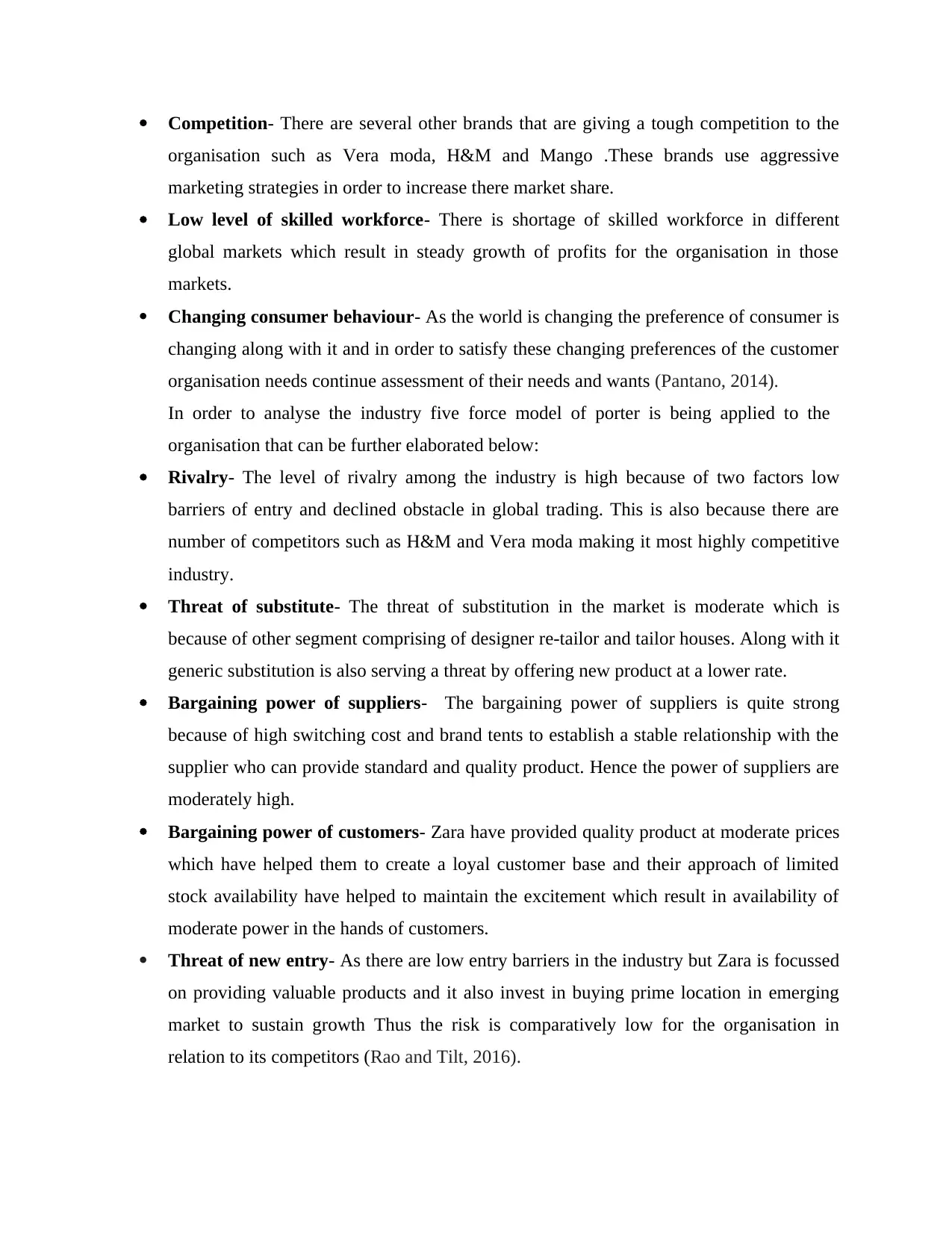
Competition- There are several other brands that are giving a tough competition to the
organisation such as Vera moda, H&M and Mango .These brands use aggressive
marketing strategies in order to increase there market share.
Low level of skilled workforce- There is shortage of skilled workforce in different
global markets which result in steady growth of profits for the organisation in those
markets.
Changing consumer behaviour- As the world is changing the preference of consumer is
changing along with it and in order to satisfy these changing preferences of the customer
organisation needs continue assessment of their needs and wants (Pantano, 2014).
In order to analyse the industry five force model of porter is being applied to the
organisation that can be further elaborated below:
Rivalry- The level of rivalry among the industry is high because of two factors low
barriers of entry and declined obstacle in global trading. This is also because there are
number of competitors such as H&M and Vera moda making it most highly competitive
industry.
Threat of substitute- The threat of substitution in the market is moderate which is
because of other segment comprising of designer re-tailor and tailor houses. Along with it
generic substitution is also serving a threat by offering new product at a lower rate.
Bargaining power of suppliers- The bargaining power of suppliers is quite strong
because of high switching cost and brand tents to establish a stable relationship with the
supplier who can provide standard and quality product. Hence the power of suppliers are
moderately high.
Bargaining power of customers- Zara have provided quality product at moderate prices
which have helped them to create a loyal customer base and their approach of limited
stock availability have helped to maintain the excitement which result in availability of
moderate power in the hands of customers.
Threat of new entry- As there are low entry barriers in the industry but Zara is focussed
on providing valuable products and it also invest in buying prime location in emerging
market to sustain growth Thus the risk is comparatively low for the organisation in
relation to its competitors (Rao and Tilt, 2016).
organisation such as Vera moda, H&M and Mango .These brands use aggressive
marketing strategies in order to increase there market share.
Low level of skilled workforce- There is shortage of skilled workforce in different
global markets which result in steady growth of profits for the organisation in those
markets.
Changing consumer behaviour- As the world is changing the preference of consumer is
changing along with it and in order to satisfy these changing preferences of the customer
organisation needs continue assessment of their needs and wants (Pantano, 2014).
In order to analyse the industry five force model of porter is being applied to the
organisation that can be further elaborated below:
Rivalry- The level of rivalry among the industry is high because of two factors low
barriers of entry and declined obstacle in global trading. This is also because there are
number of competitors such as H&M and Vera moda making it most highly competitive
industry.
Threat of substitute- The threat of substitution in the market is moderate which is
because of other segment comprising of designer re-tailor and tailor houses. Along with it
generic substitution is also serving a threat by offering new product at a lower rate.
Bargaining power of suppliers- The bargaining power of suppliers is quite strong
because of high switching cost and brand tents to establish a stable relationship with the
supplier who can provide standard and quality product. Hence the power of suppliers are
moderately high.
Bargaining power of customers- Zara have provided quality product at moderate prices
which have helped them to create a loyal customer base and their approach of limited
stock availability have helped to maintain the excitement which result in availability of
moderate power in the hands of customers.
Threat of new entry- As there are low entry barriers in the industry but Zara is focussed
on providing valuable products and it also invest in buying prime location in emerging
market to sustain growth Thus the risk is comparatively low for the organisation in
relation to its competitors (Rao and Tilt, 2016).
Paraphrase This Document
Need a fresh take? Get an instant paraphrase of this document with our AI Paraphraser
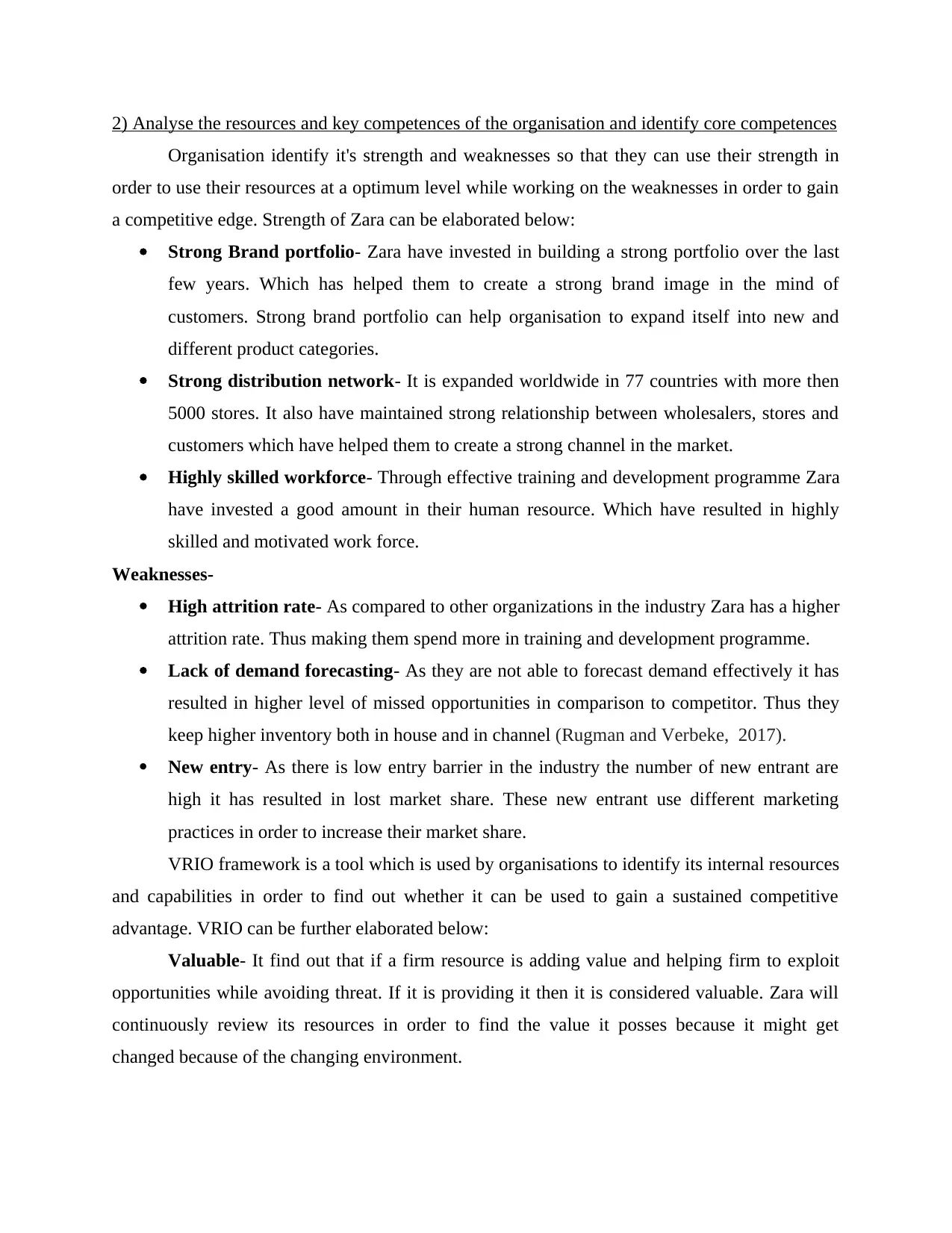
2) Analyse the resources and key competences of the organisation and identify core competences
Organisation identify it's strength and weaknesses so that they can use their strength in
order to use their resources at a optimum level while working on the weaknesses in order to gain
a competitive edge. Strength of Zara can be elaborated below:
Strong Brand portfolio- Zara have invested in building a strong portfolio over the last
few years. Which has helped them to create a strong brand image in the mind of
customers. Strong brand portfolio can help organisation to expand itself into new and
different product categories.
Strong distribution network- It is expanded worldwide in 77 countries with more then
5000 stores. It also have maintained strong relationship between wholesalers, stores and
customers which have helped them to create a strong channel in the market.
Highly skilled workforce- Through effective training and development programme Zara
have invested a good amount in their human resource. Which have resulted in highly
skilled and motivated work force.
Weaknesses-
High attrition rate- As compared to other organizations in the industry Zara has a higher
attrition rate. Thus making them spend more in training and development programme.
Lack of demand forecasting- As they are not able to forecast demand effectively it has
resulted in higher level of missed opportunities in comparison to competitor. Thus they
keep higher inventory both in house and in channel (Rugman and Verbeke, 2017).
New entry- As there is low entry barrier in the industry the number of new entrant are
high it has resulted in lost market share. These new entrant use different marketing
practices in order to increase their market share.
VRIO framework is a tool which is used by organisations to identify its internal resources
and capabilities in order to find out whether it can be used to gain a sustained competitive
advantage. VRIO can be further elaborated below:
Valuable- It find out that if a firm resource is adding value and helping firm to exploit
opportunities while avoiding threat. If it is providing it then it is considered valuable. Zara will
continuously review its resources in order to find the value it posses because it might get
changed because of the changing environment.
Organisation identify it's strength and weaknesses so that they can use their strength in
order to use their resources at a optimum level while working on the weaknesses in order to gain
a competitive edge. Strength of Zara can be elaborated below:
Strong Brand portfolio- Zara have invested in building a strong portfolio over the last
few years. Which has helped them to create a strong brand image in the mind of
customers. Strong brand portfolio can help organisation to expand itself into new and
different product categories.
Strong distribution network- It is expanded worldwide in 77 countries with more then
5000 stores. It also have maintained strong relationship between wholesalers, stores and
customers which have helped them to create a strong channel in the market.
Highly skilled workforce- Through effective training and development programme Zara
have invested a good amount in their human resource. Which have resulted in highly
skilled and motivated work force.
Weaknesses-
High attrition rate- As compared to other organizations in the industry Zara has a higher
attrition rate. Thus making them spend more in training and development programme.
Lack of demand forecasting- As they are not able to forecast demand effectively it has
resulted in higher level of missed opportunities in comparison to competitor. Thus they
keep higher inventory both in house and in channel (Rugman and Verbeke, 2017).
New entry- As there is low entry barrier in the industry the number of new entrant are
high it has resulted in lost market share. These new entrant use different marketing
practices in order to increase their market share.
VRIO framework is a tool which is used by organisations to identify its internal resources
and capabilities in order to find out whether it can be used to gain a sustained competitive
advantage. VRIO can be further elaborated below:
Valuable- It find out that if a firm resource is adding value and helping firm to exploit
opportunities while avoiding threat. If it is providing it then it is considered valuable. Zara will
continuously review its resources in order to find the value it posses because it might get
changed because of the changing environment.
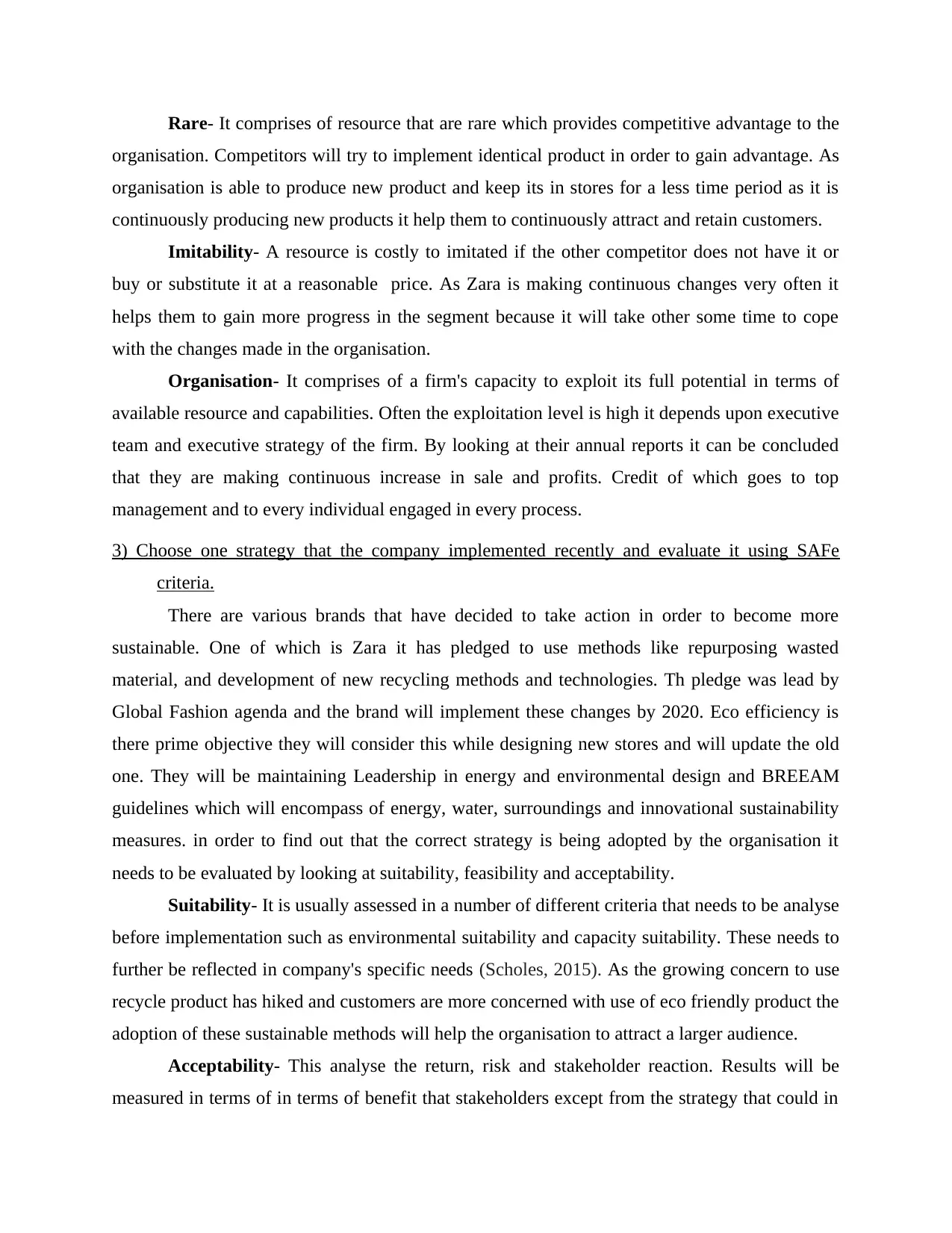
Rare- It comprises of resource that are rare which provides competitive advantage to the
organisation. Competitors will try to implement identical product in order to gain advantage. As
organisation is able to produce new product and keep its in stores for a less time period as it is
continuously producing new products it help them to continuously attract and retain customers.
Imitability- A resource is costly to imitated if the other competitor does not have it or
buy or substitute it at a reasonable price. As Zara is making continuous changes very often it
helps them to gain more progress in the segment because it will take other some time to cope
with the changes made in the organisation.
Organisation- It comprises of a firm's capacity to exploit its full potential in terms of
available resource and capabilities. Often the exploitation level is high it depends upon executive
team and executive strategy of the firm. By looking at their annual reports it can be concluded
that they are making continuous increase in sale and profits. Credit of which goes to top
management and to every individual engaged in every process.
3) Choose one strategy that the company implemented recently and evaluate it using SAFe
criteria.
There are various brands that have decided to take action in order to become more
sustainable. One of which is Zara it has pledged to use methods like repurposing wasted
material, and development of new recycling methods and technologies. Th pledge was lead by
Global Fashion agenda and the brand will implement these changes by 2020. Eco efficiency is
there prime objective they will consider this while designing new stores and will update the old
one. They will be maintaining Leadership in energy and environmental design and BREEAM
guidelines which will encompass of energy, water, surroundings and innovational sustainability
measures. in order to find out that the correct strategy is being adopted by the organisation it
needs to be evaluated by looking at suitability, feasibility and acceptability.
Suitability- It is usually assessed in a number of different criteria that needs to be analyse
before implementation such as environmental suitability and capacity suitability. These needs to
further be reflected in company's specific needs (Scholes, 2015). As the growing concern to use
recycle product has hiked and customers are more concerned with use of eco friendly product the
adoption of these sustainable methods will help the organisation to attract a larger audience.
Acceptability- This analyse the return, risk and stakeholder reaction. Results will be
measured in terms of in terms of benefit that stakeholders except from the strategy that could in
organisation. Competitors will try to implement identical product in order to gain advantage. As
organisation is able to produce new product and keep its in stores for a less time period as it is
continuously producing new products it help them to continuously attract and retain customers.
Imitability- A resource is costly to imitated if the other competitor does not have it or
buy or substitute it at a reasonable price. As Zara is making continuous changes very often it
helps them to gain more progress in the segment because it will take other some time to cope
with the changes made in the organisation.
Organisation- It comprises of a firm's capacity to exploit its full potential in terms of
available resource and capabilities. Often the exploitation level is high it depends upon executive
team and executive strategy of the firm. By looking at their annual reports it can be concluded
that they are making continuous increase in sale and profits. Credit of which goes to top
management and to every individual engaged in every process.
3) Choose one strategy that the company implemented recently and evaluate it using SAFe
criteria.
There are various brands that have decided to take action in order to become more
sustainable. One of which is Zara it has pledged to use methods like repurposing wasted
material, and development of new recycling methods and technologies. Th pledge was lead by
Global Fashion agenda and the brand will implement these changes by 2020. Eco efficiency is
there prime objective they will consider this while designing new stores and will update the old
one. They will be maintaining Leadership in energy and environmental design and BREEAM
guidelines which will encompass of energy, water, surroundings and innovational sustainability
measures. in order to find out that the correct strategy is being adopted by the organisation it
needs to be evaluated by looking at suitability, feasibility and acceptability.
Suitability- It is usually assessed in a number of different criteria that needs to be analyse
before implementation such as environmental suitability and capacity suitability. These needs to
further be reflected in company's specific needs (Scholes, 2015). As the growing concern to use
recycle product has hiked and customers are more concerned with use of eco friendly product the
adoption of these sustainable methods will help the organisation to attract a larger audience.
Acceptability- This analyse the return, risk and stakeholder reaction. Results will be
measured in terms of in terms of benefit that stakeholders except from the strategy that could in
⊘ This is a preview!⊘
Do you want full access?
Subscribe today to unlock all pages.

Trusted by 1+ million students worldwide
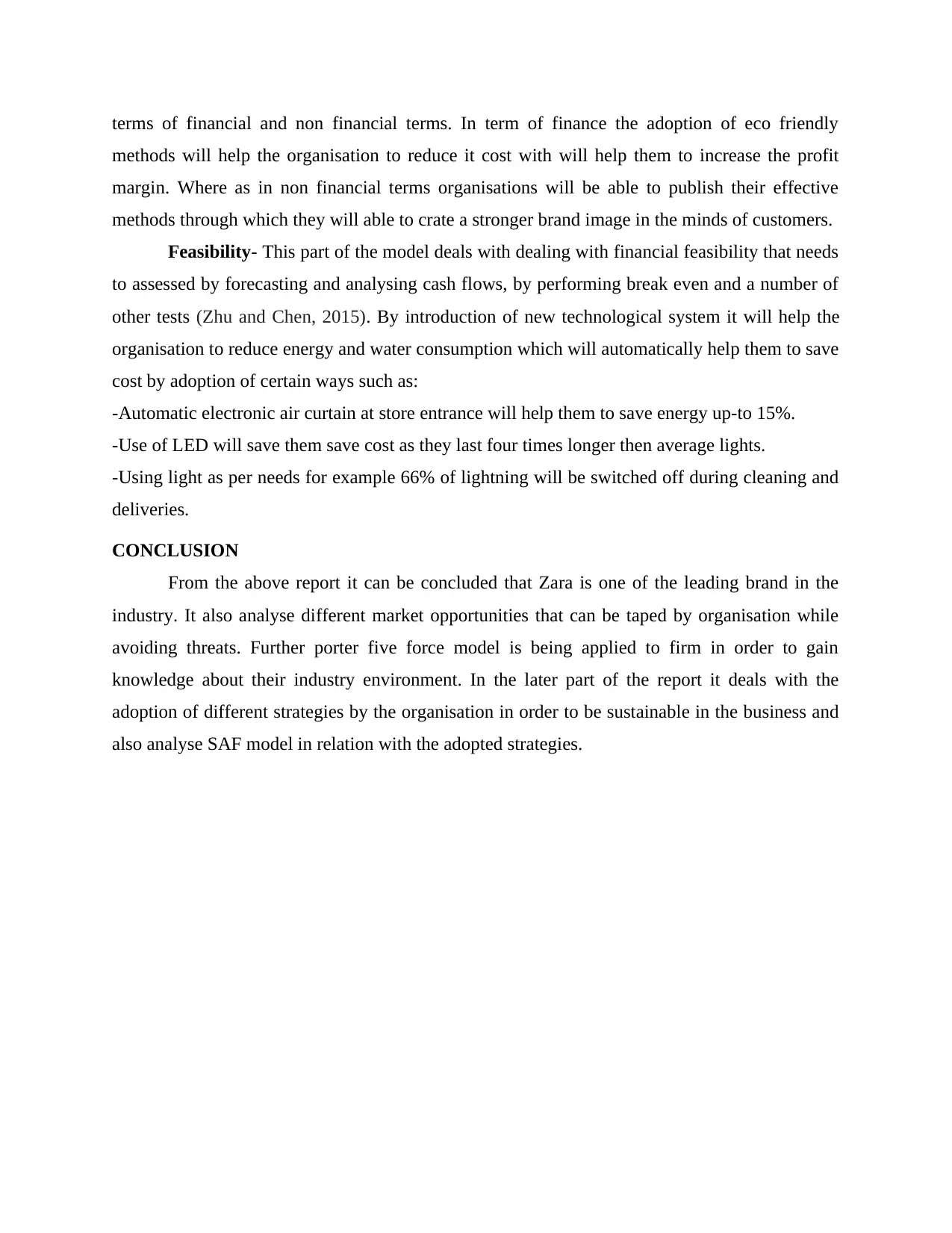
terms of financial and non financial terms. In term of finance the adoption of eco friendly
methods will help the organisation to reduce it cost with will help them to increase the profit
margin. Where as in non financial terms organisations will be able to publish their effective
methods through which they will able to crate a stronger brand image in the minds of customers.
Feasibility- This part of the model deals with dealing with financial feasibility that needs
to assessed by forecasting and analysing cash flows, by performing break even and a number of
other tests (Zhu and Chen, 2015). By introduction of new technological system it will help the
organisation to reduce energy and water consumption which will automatically help them to save
cost by adoption of certain ways such as:
-Automatic electronic air curtain at store entrance will help them to save energy up-to 15%.
-Use of LED will save them save cost as they last four times longer then average lights.
-Using light as per needs for example 66% of lightning will be switched off during cleaning and
deliveries.
CONCLUSION
From the above report it can be concluded that Zara is one of the leading brand in the
industry. It also analyse different market opportunities that can be taped by organisation while
avoiding threats. Further porter five force model is being applied to firm in order to gain
knowledge about their industry environment. In the later part of the report it deals with the
adoption of different strategies by the organisation in order to be sustainable in the business and
also analyse SAF model in relation with the adopted strategies.
methods will help the organisation to reduce it cost with will help them to increase the profit
margin. Where as in non financial terms organisations will be able to publish their effective
methods through which they will able to crate a stronger brand image in the minds of customers.
Feasibility- This part of the model deals with dealing with financial feasibility that needs
to assessed by forecasting and analysing cash flows, by performing break even and a number of
other tests (Zhu and Chen, 2015). By introduction of new technological system it will help the
organisation to reduce energy and water consumption which will automatically help them to save
cost by adoption of certain ways such as:
-Automatic electronic air curtain at store entrance will help them to save energy up-to 15%.
-Use of LED will save them save cost as they last four times longer then average lights.
-Using light as per needs for example 66% of lightning will be switched off during cleaning and
deliveries.
CONCLUSION
From the above report it can be concluded that Zara is one of the leading brand in the
industry. It also analyse different market opportunities that can be taped by organisation while
avoiding threats. Further porter five force model is being applied to firm in order to gain
knowledge about their industry environment. In the later part of the report it deals with the
adoption of different strategies by the organisation in order to be sustainable in the business and
also analyse SAF model in relation with the adopted strategies.
Paraphrase This Document
Need a fresh take? Get an instant paraphrase of this document with our AI Paraphraser
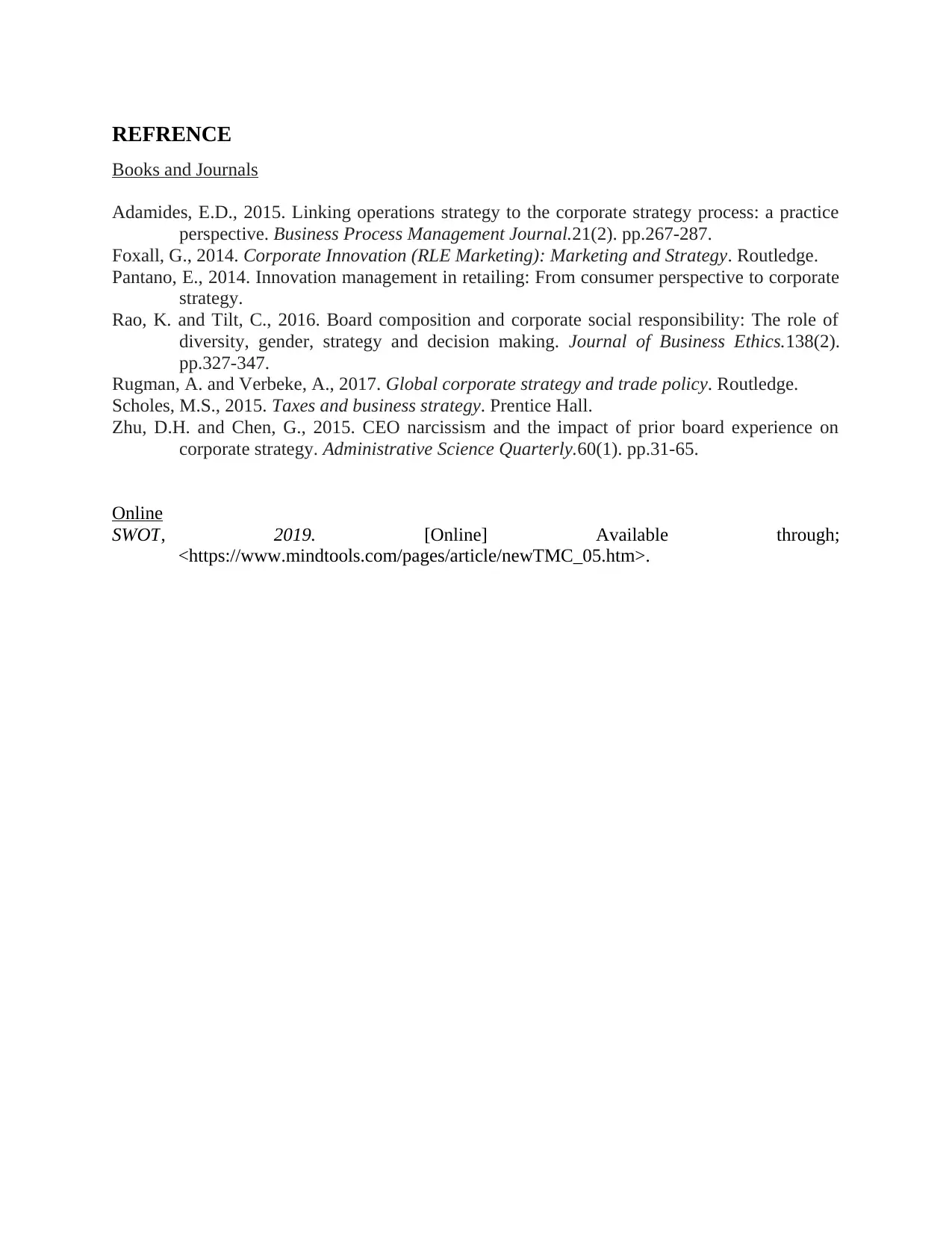
REFRENCE
Books and Journals
Adamides, E.D., 2015. Linking operations strategy to the corporate strategy process: a practice
perspective. Business Process Management Journal.21(2). pp.267-287.
Foxall, G., 2014. Corporate Innovation (RLE Marketing): Marketing and Strategy. Routledge.
Pantano, E., 2014. Innovation management in retailing: From consumer perspective to corporate
strategy.
Rao, K. and Tilt, C., 2016. Board composition and corporate social responsibility: The role of
diversity, gender, strategy and decision making. Journal of Business Ethics.138(2).
pp.327-347.
Rugman, A. and Verbeke, A., 2017. Global corporate strategy and trade policy. Routledge.
Scholes, M.S., 2015. Taxes and business strategy. Prentice Hall.
Zhu, D.H. and Chen, G., 2015. CEO narcissism and the impact of prior board experience on
corporate strategy. Administrative Science Quarterly.60(1). pp.31-65.
Online
SWOT, 2019. [Online] Available through;
<https://www.mindtools.com/pages/article/newTMC_05.htm>.
Books and Journals
Adamides, E.D., 2015. Linking operations strategy to the corporate strategy process: a practice
perspective. Business Process Management Journal.21(2). pp.267-287.
Foxall, G., 2014. Corporate Innovation (RLE Marketing): Marketing and Strategy. Routledge.
Pantano, E., 2014. Innovation management in retailing: From consumer perspective to corporate
strategy.
Rao, K. and Tilt, C., 2016. Board composition and corporate social responsibility: The role of
diversity, gender, strategy and decision making. Journal of Business Ethics.138(2).
pp.327-347.
Rugman, A. and Verbeke, A., 2017. Global corporate strategy and trade policy. Routledge.
Scholes, M.S., 2015. Taxes and business strategy. Prentice Hall.
Zhu, D.H. and Chen, G., 2015. CEO narcissism and the impact of prior board experience on
corporate strategy. Administrative Science Quarterly.60(1). pp.31-65.
Online
SWOT, 2019. [Online] Available through;
<https://www.mindtools.com/pages/article/newTMC_05.htm>.
1 out of 8
Related Documents
Your All-in-One AI-Powered Toolkit for Academic Success.
+13062052269
info@desklib.com
Available 24*7 on WhatsApp / Email
![[object Object]](/_next/static/media/star-bottom.7253800d.svg)
Unlock your academic potential
Copyright © 2020–2025 A2Z Services. All Rights Reserved. Developed and managed by ZUCOL.





